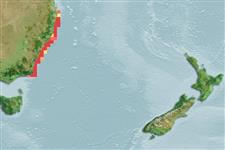Ikan bertulang rawan (sharks and rays) >
Rhinopristiformes (Shovelnose rays) >
Trygonorrhinidae (Banjo rays, Fiddler rays)
Etymology: Trygonorrhina: Greek, trygon = a sting ray + Greek, rhinos = nose (Ref. 45335).
More on authors: Müller & Henle.
Environment: milieu / climate zone / depth range / distribution range
Ekologi
laut dasar (demersal); kisaran kedalaman 0 - 100 m (Ref. 114953). Subtropical; 28°S - 38°S, 149°E - 155°E (Ref. 114953)
Southwest Pacific: endemic to eastern Australia.
Size / Weight / umur
Maturity: Lm ? range ? - ? cm
Max length : 120 cm TL jantan/; (Ref. 114953); Berat maksimum terpublikasi: 6.7 kg (Ref. 6870)
This large shovelnose ray is distinguished by the following characters: suboval disc, short and broadly rounded snout with nostrils partly covered with a large nasal curtain; sharp thorns present on mid-line of disc and shoulders; behind interorbital space is an ornate pattern of dark-edged bands with distinct triangular or diamond-shaped marking (Ref. 114953).
A benthic species and an active scavenger which will enter fish traps and often becoming ensnared by the disc (Ref. 6871). Found also on sandy bottoms and seagrass areas, often near rocky reefs (Ref. 12951). Mainly feeds on crabs and shrimps (Ref. 114953). Ovoviviparous with golden egg capsules, each with up to 3 embryos (Ref. 12951). Produces up to 2-3 pups. Length size seldom exceeds 110 cm TL; birth size at ca. 25 cm TL (Ref. 114953). The flesh is good to eat, although only a small quantity is sold in seafood outlets (Ref. 6871).
Life cycle and mating behavior
Kematangan | Reproduksi, perkembang biakan | Pemijahan | telur-telur | Fecundity | Larva
Exhibit ovoviparity (aplacental viviparity), with embryos feeding initially on yolk, then receiving additional nourishment from the mother by indirect absorption of uterine fluid enriched with mucus, fat or protein through specialised structures (Ref. 50449).
Last, P.R., W.T. White, M.R. de Carvalho, B. Séret, M.F.W. Stehmann and G.J.P. Naylor, 2016. Rays of the world. CSIRO Publishing, Comstock Publishing Associates. i-ix + 1-790. (Ref. 114953)
Status IUCN Red List (Ref. 130435)
ancaman kepada manusia
Harmless
penggunaan manusia
Perikanan: nilai komersial kecil; Ikan buruan: ya; Akuarium: Akuarium publik
informasi lanjut
AcuanBudidaya airprofil budidaya airStrainGenetikaElectrophoresesDiturunkanPenyakit-penyakitPengolahanNutrientsMass conversion
mitraGambarStamps, Coins Misc.Suara-suaraCiguateraKecepatanTipe renangArea insangOtolithsOtakPenglihatan / visi
Alat, peralatan
laporan khas
muat turun XML
Sumber internet
Estimates based on models
Preferred temperature (Ref.
123201): 17.3 - 22.5, mean 20.7 °C (based on 18 cells).
Phylogenetic diversity index (Ref.
82804): PD
50 = 0.6250 [Uniqueness, from 0.5 = low to 2.0 = high].
Bayesian length-weight: a=0.00724 (0.00267 - 0.01964), b=3.00 (2.76 - 3.24), in cm total length, based on LWR estimates for this (Sub)family-body shape (Ref.
93245).
Trophic level (Ref.
69278): 3.7 ±0.6 se; based on size and trophs of closest relatives
Daya lenting (Ref.
120179): Rendah, Waktu penggandaan populasi minimum 4.5 - 14 tahun (Fec assumed to be <100).
Fishing Vulnerability (Ref.
59153): High to very high vulnerability (72 of 100).
Nutrients (Ref.
124155): Calcium = 21.8 [4.2, 100.2] mg/100g; Iron = 0.68 [0.18, 1.97] mg/100g; Protein = 19.3 [17.2, 21.2] %; Omega3 = 0.211 [0.096, 0.452] g/100g; Selenium = 25.1 [7.4, 71.4] μg/100g; VitaminA = 7.73 [2.65, 21.92] μg/100g; Zinc = 0.561 [0.278, 1.008] mg/100g (wet weight);
